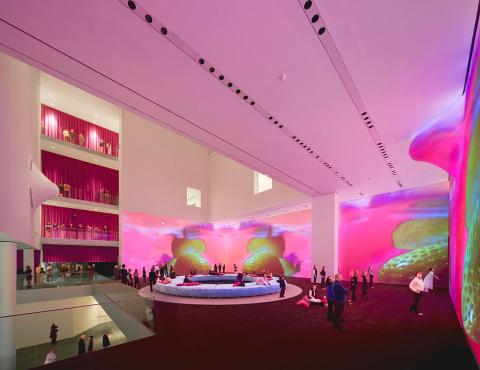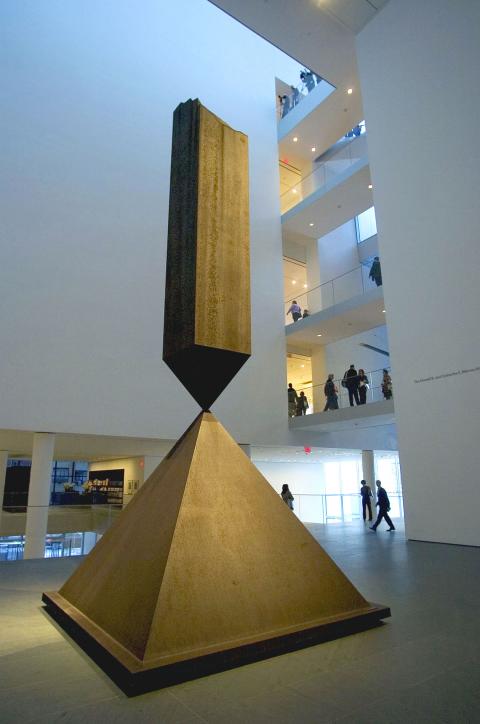When I walk through the Museum of Modern Art (MoMA) these days, it sometimes feels as if the place has come back from the dead — even if I’m not always so crazy about the life it happens to be leading. There’s often a confusing, disjunctive quality to it, especially where contemporary art is concerned, as the museum’s programming lurches from crowd-drawing, performance-art spectacles in the atrium to relatively dry and didactic exhibitions in its galleries. But at least there’s a pulse.
The museum feels much, much more animated than it did back in 2005 and 2006, when it — and we — were first adjusting to its slick new home on West 53rd Street. That structure, designed by Yoshio Taniguchi and built at a cost of more than US$800 million, opened in November 2004, and over the next two years it appeared to many depressed MoMA watchers that we were witnessing nothing less than a major museum’s suicide by architecture.
The building was fussy and sterile. The galleries felt too small (and still do), and the confusion and congestion of the network of hallways, escalators and elevators connecting them were extremely unpleasant (and still are). The total effect was overwhelmingly corporate, and a seeming betrayal of MoMA’s stated goal for the expansion: creating more breathing room for its existing and future collections, not to mention its public. And it was hard to see how under these constraints the museum was going to grow beyond its longtime role as guardian of its stringent, male-dominated, Cubist-based version of Modernism, as many had hoped the expansion would finally allow it to do.

photo: Bloomberg
And then there was the chilly and badly proportioned trophy-space atrium — four stories of spatial extravagance that the museum could ill afford. In the early days it was the leading symbol of the new building’s failed vision, and its effect on the art shown within it was dismal. Remember how Barnett Newman’s Broken Obelisk resembled a stake in the heart — albeit an ineffectual one — of the atrium’s vastness? Or the humiliating way that vastness made fairly robust paintings like Monet’s Water Lilies shrivel?
You may not. These days the atrium has become a symbol of something that might be called the New Modern. It is the most prominent sign of the museum’s giddy, even desperate, embrace of the new and the next, of large-scale installation and video art, as well as performance art, and generally of art as entertainment and spectacle. As such, the atrium is both a measure of MoMa’s new vitality and a symptom of something more than a little scary about where contemporary art is headed, or where the Modern is taking it. (Hint: Conceptual Art is the new Cubism.)
Like many museumgoers I can feel deeply ambivalent about what goes on in the atrium — variously vexed, seduced, pandered to, alienated and moved. Still, I think its transformation counts as progress. At least now, instead of worrying about the Modern’s vital signs, we can worry once more about what it is and isn’t doing, about the new life it has taken on.

photo: Bloomberg
This much is certain: MoMa isn’t sitting on its hands. Its tribe of curators is for the most part struggling with the building, which unfortunately usually means cramming too much art into its too small galleries. But the curators are also trying to make the most of their extraordinary collections and to free the museum from the straitjacket of art after, out of and up from Picasso. The increased attention to South American modernism is, for example, extraordinary. Too frequently, however, it seems that the curators revert to type, succumbing to the ingrained gravitational pull of the MoMA mindset. This is an institution, after all, that as much as ever wants to end up on the right side of history.
You can see it in the museum’s gorgeous yet predictable installation of Abstract Expressionist paintings now arrayed on the fourth floor, where the curator, Ann Temkin, refused to crowd the art and ended up with a lavish greatest-hits parade that involved very little rethinking of the canon. But you can also see it in the current On Line: Drawing Through the Twentieth Century, which starts with Braque and Picasso (surprise!) and includes numerous underknown artists, often female ones, from around the world. It is so stylistically severe and monotonous that its ultimate effect is orthodox and close minded. It ends with an innocuous performance video of an artist arranging a bit of string on a table.
In other words, On Line once more traces what seems to be becoming the Modern’s sacred text: the “dematerialization of the art object” set in motion by Conceptual Art and its derivatives, Process Art, earthworks and performance. You can see the same epic played out in the latest display of art since 1970 on the museum’s second floor, as it was in many of its predecessors. Someone needs to turn the page. Contemporary art is simply too broad and rich to be so narrowly confined.

photo: Bloomberg
To its credit, perhaps, MoMa has become the leading exemplar of the changing role of new art in museums. Where museums used to be vaguely or overtly suspicious of the new, allowing it through the door only hesitantly, now they can’t get enough of it, or at least certain kinds of it.
In this month’s Artforum the French gallerist-writer Francois Piron refers to the we-can-show-anything openness of today’s museums as “museal porosity,” citing the Modern’s recent sideshow-like Marina Abramovic retrospective, sprinkled with nude performers.
Clearly the Modern’s “museal porosity” is most extreme in the atrium. Here we witness the new awareness of an ever growing, ever more attention-deficient audience and of the ways Conceptual Art and performance art speed up art consumption with the favoring of message over medium, of the relative simplicity of narrative over the complexities of form.
Over the past few years you could say that MoMa has endeavored to retrain its audience with a combination of deprivation and reward. The public is learning that it can do without actual art objects as long as there is a payoff, preferably moving video images or live performers and a modicum of nudity. Which is to say that despite all the multiple-medium hustle and bustle of the new MoMa, one thing stands out: its almost complete disregard for contemporary painting. These days that has largely been relegated to the museum’s lobby or hallways.
The evolution of the atrium from dead zone to nerve center is a fascinating part of MoMa’s history that will probably one day have its own book — or exhibition. High points would include the 2006 installation of Rhapsody, Jennifer Bartlett’s 1975 to 1976 encyclopedic romp through the basics of representational and abstract painting conducted across nearly 1,000 30cm by 30cm enamel-on-steel plates. Wrapped around all three walls of the atrium, it was an early sign of the space’s potential for spectacle. In May 2007 viewers watched as the Romanian artist Dan Perjovschi spent two weeks making a wall drawing of fey, politically slanted cartoons that scaled the atrium. It was, in a way, the space’s first performance piece.
Soon the atrium was being annexed for larger works, set pieces and installations tied to the monographic surveys and retrospectives in the temporary exhibition galleries upstairs. Martin Puryear went first in the fall of 2007 with several works, including a tall, elegantly attenuated ladder. Olafur Eliasson dangled an electric fan overhead that became its own propeller, swinging itself back and forth, and Gabriel Orozco suspended an entire whale skeleton. Martin Kippenberger’s Happy End of Franz Kafka’s Amerika arrived in early 2009 — an expanse of cockeyed furniture simulating a demonic corporate office — and was memorable from every possible vantage point.
But the atrium was truly anointed as the billboard for the new, feisty radicality at the end of 2008. That was when Pipilotti Rist, one of the few women to tackle the atrium, covered its walls with giant video images in Pour Your Body Out (7354 Cubic Meters) — close-ups of red tulips, a menstruating swimmer and a rooting pig. The piece also involved an immense island of thickly cushioned divans where legions of people lolled, looked, snapped photographs and drifted off. Joseph Beuys’ famous term “social sculpture” took new meaning: hanging out.
Like the Tate Modern’s immense Turbine Hall in London, the atrium is a place where you can expect to be surprised, even shocked, by the latest thing, raw, still wriggling on the hook, just pulled out of some portion of the ocean of art. Wow! You mean sitting down at a table and staring into a woman’s (Marina Abramovic’s) eyes is art? Far out.
Screeching into a microphone at the top of my lungs is art? Yes, and it isn’t even all that new. This was Voice Piece for Soprano, a 1961 work by Yoko Ono, the Fluxus artist. The shrieks and yells, occasional o-o-oms and bits harmonizing it elicited from museum visitors lasted from June through November, adding regular jolts to the museum’s already fairly high noise levels and serving notice that not every juvenile, superficially avant-garde idea improves with age.
Thankfully the Ono was replaced last month by a marvelous, newly acquired 2008 performance-sculpture by the artist team Allora & Calzadilla that restored my faith in the whole idea of collecting performance art. It involves a baby-grand piano with a hole cut through its center, making room for a performer who plays the last movement of Beethoven’s Ninth Symphony from the inside. The work provides a complex aesthetic experience while blurring the boundaries between traditional mediums and demonstrating the way that new art comes from old. It is, in short, everything that the Ono is not.
Of course, performance art has not been limited to the atrium. In its galleries MoMA has recently started mounting exhibitions documenting the work of various performance artists, among them Tehching Hsieh (謝德慶) and Joan Jonas, and some of these have been wonderful. Nor is the atrium the only place where superficial sensationalism can be found. Take the current easy-viewing exhibition of film and limpid, glamorously digitalized screen tests by Andy Warhol, minimally organized by the museum’s curator at large, Klaus Biesenbach. I guess the show gets credit for being the least harried exhibition since MoMA reopened its doors. But it is also the most vacant: fast and light, a path of almost no resistance. It’s fun, with oodles of star power, but barely an exhibition at all.
Too often these days if you want to see art of real psycho-visual-formal substance, you have to fight the crowds in the permanent collection on the fourth and fifth floors. Too much of the recent art tends to either titillate or lecture. One way or the other, it is more about explanation than experience, about narrative than form.
There are exceptions, however, sometimes in the galleries but more reliably in the lobby. At the moment I recommend Elizabeth Murray’s imposing Do the Dance from 2005, which currently hangs above one of the information desks down there. A vivacious, suavely cartoonish jangle of shaped canvases in which the body is obliquely in evidence, it is surrounded by plenty of space, a rarity at the museum these days. It hangs in splendid isolation, outside both the teeming galleries and the latest version of history that seems to so preoccupy the new MoMA.

June 2 to June 8 Taiwan’s woodcutters believe that if they see even one speck of red in their cooked rice, no matter how small, an accident is going to happen. Peng Chin-tian (彭錦田) swears that this has proven to be true at every stop during his decades-long career in the logging industry. Along with mining, timber harvesting was once considered the most dangerous profession in Taiwan. Not only were mishaps common during all stages of processing, it was difficult to transport the injured to get medical treatment. Many died during the arduous journey. Peng recounts some of his accidents in

“Why does Taiwan identity decline?”a group of researchers lead by University of Nevada political scientist Austin Wang (王宏恩) asked in a recent paper. After all, it is not difficult to explain the rise in Taiwanese identity after the early 1990s. But no model predicted its decline during the 2016-2018 period, they say. After testing various alternative explanations, Wang et al argue that the fall-off in Taiwanese identity during that period is related to voter hedging based on the performance of the Democratic Progressive Party (DPP). Since the DPP is perceived as the guardian of Taiwan identity, when it performs well,

A short walk beneath the dense Amazon canopy, the forest abruptly opens up. Fallen logs are rotting, the trees grow sparser and the temperature rises in places sunlight hits the ground. This is what 24 years of severe drought looks like in the world’s largest rainforest. But this patch of degraded forest, about the size of a soccer field, is a scientific experiment. Launched in 2000 by Brazilian and British scientists, Esecaflor — short for “Forest Drought Study Project” in Portuguese — set out to simulate a future in which the changing climate could deplete the Amazon of rainfall. It is

The Taiwan People’s Party (TPP) on May 18 held a rally in Taichung to mark the anniversary of President William Lai’s (賴清德) inauguration on May 20. The title of the rally could be loosely translated to “May 18 recall fraudulent goods” (518退貨ㄌㄨㄚˋ!). Unlike in English, where the terms are the same, “recall” (退貨) in this context refers to product recalls due to damaged, defective or fraudulent merchandise, not the political recalls (罷免) currently dominating the headlines. I attended the rally to determine if the impression was correct that the TPP under party Chairman Huang Kuo-Chang (黃國昌) had little of a